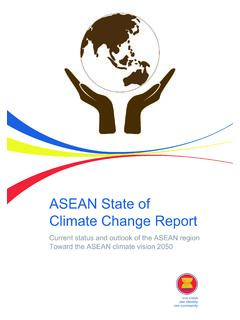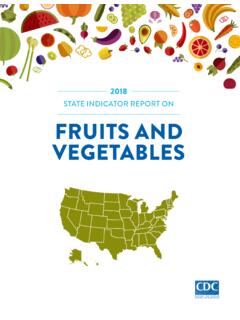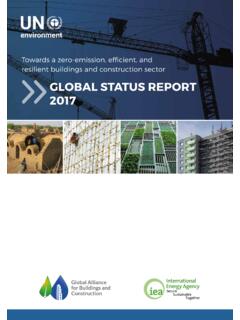Transcription of The state of the environment soil - GOV.UK
1 Customer service line 03706 506 506 floodline 03459 88 11 88 incident hotline 0800 80 70 60 The state of the environment : soil June 2019 Chair's foreword soil holds 3 times as much carbon as the atmosphere, it reduces the risk of flooding by absorbing water, it is a wildlife habitat, and it delivers 95% of global food supplies. Unfortunately, it is a limited resource under pressure from climate change, population growth, urban development, waste, pollution, and the demand for more (and cheaper) food. This report aims to widen understanding about the state of soils. Leonardo Da Vinci said we know more about the movement of celestial bodies than about the soil underfoot and 500 years later, there is less information about soil than any other part of the environment .
2 Defra Secretary of state , Michael Gove, said: Countries can withstand coups d tat, wars and conflict, even leaving the EU, but no country can withstand the loss of its soil and fertility . We welcome the government s work to move this up the political agenda both domestically and internationally. For example, the Department for International Development s work helping farmers around the world adapt to climate change. UK soil contains about 10 billion tonnes of carbon, roughly equal to 80 years of annual greenhouse gas emissions. Intensive agriculture has caused arable soils to lose 40 to 60% of their organic carbon, and the impacts of climate change pose further risks.
3 Extended periods of wet weather can cause widespread damage to soil structure. Very heavy rainfall and thunderstorms cause soil erosion which exacerbates flood risks. soil carbon loss is an act of economic and environmental self-harm. If we are serious about the Committee on Climate Change s target of net zero by 2050, then we need investment, regulation, better management of our bogs and peatlands, and collaboration with, and between, farmers. Farmers manage 70% of the land. Poor soil quality affects their income and way of life. We work closely with farmers, providing advice, guidance and practical support. In Cumbria s Eden catchment we are supporting a peer group learning about best practice.
4 Upstream Thinking , funded by South West Water, is a good example of collaborative working to improve drinking water quality. 2 of 22 The new Farming Rules for Water will help. At present, there is low awareness about the new rules, so we are taking an advice led approach to help farmers meet the requirements. However, we will not hesitate to take enforcement action for pollution incidents where people are not acting in good faith. We are also working on farm assurance schemes with WRAP, the National Farmers Union, and the Renewable Energy Association, to address both the plastic waste produced by agriculture, and to reduce plastic contamination in bio-waste spread on farmland.
5 If badly managed, landspreading can damage soil health, contaminate crops and livestock, and it can affect the aquatic environment and bathing waters. We will continue to work with water companies and the waste sector to manage this risk. Emma Howard, Chair of the environment Agency 3 of 22 Key findings soil is an important natural capital resource, providing many essential services. There is insufficient data on the health of our soils and investment is needed in soil monitoring. soil degradation was calculated in 2010 to cost billion every year. Almost 4 million hectares of soil are at risk of compaction in England and Wales, affecting soil fertility and our water resources, and increasing the risk of flooding.
6 Over 2 million hectares of soil are at risk of erosion in England and Wales. soil biodiversity and the many biological processes and soil functions that it supports are thought to be under threat. Wasting food and growing crops for bioenergy are putting additional pressure on soils. UK soils currently store about 10 billion tonnes of carbon, roughly equal to 80 years of annual UK greenhouse gas emissions. Intensive agriculture has caused arable soils to lose about 40 to 60% of their organic carbon. Spreading of some materials can give rise to contamination. Some 300,000 hectares are contaminated in the UK.
7 Microplastics are widespread in soil with unknown consequences. Reversing soil degradation and restoring fertility by 2030 is an aim of the government s 25 Year environment Plan. The proposed Environmental Land Management scheme provides an opportunity to reward farmers for protecting and regenerating soils. 4 of 22 Contents Why soil is important .. 5 Lack of evidence .. 6 soil types and use .. 6 state and trends .. 7 soil health .. 7 Physical factors .. 7 soil compaction .. 7 soil erosion .. 8 soil sealing .. 10 Biological factors .. 10 Organic matter .. 10 soil biology .. 11 Chemical factors.
8 12 Nutrients .. 12 Acidification .. 12 Contamination .. 13 Current and future pressures .. 14 Agriculture .. 14 Climate change .. 16 Population growth .. 16 Emerging pollutants .. 16 Looking ahead .. 17 5 of 22 Why soil is important Government policy after the Second World War supported a significant increase in land used for agricultural production, converting permanent grasslands into tilled farmland. This has created a legacy of ever increasing intensification of farmland and degradation of soil . Pursuing agricultural production in the short term can result in soil degradation that limits the ability of soil to perform other functions.
9 Some parts of the country such as fenland peats could be only 30 to 60 years away from the fundamental eradication of soil ,2 However, the sustainable management of agricultural soils, including maintaining or enhancing the levels of soil organic carbon levels can provide multiple soil is an important natural capital resource, providing many essential services, as highlighted recently by the Natural Capital These include: supplying a suitable environment and conditions to grow food reducing the risk of flooding by absorbing water filtering water absorbing and reducing pollutants regulating our climate and gases in the atmosphere providing habitat for soil dwelling organisms and their associated services such as pest control and pollination protecting cultural heritage providing a stable platform for buildings providing raw materials the potential for new life saving medicines5 Maintaining healthy soils is important for food security.
10 With 55% of the food consumed in the UK being produced Some 95% of global food supplies are directly or indirectly produced on Around 129,000 hectares of agricultural land were used to grow crops for bioenergy in the UK in 2017, just over 2% of all arable land in the soil holds 3 times as much carbon as the atmosphere. UK soils currently store about 10 billion tonnes of carbon, roughly equal to 80 years of current annual UK greenhouse gas However, degradation has led to most arable soils having already lost 40 to 60% of their organic ,11 In 2010, soil degradation in England and Wales was estimated to cost billion a Improved farming practices and land use are needed to rebuild the soil s carbon stores and prevent the generation of greenhouse gases from soil .














